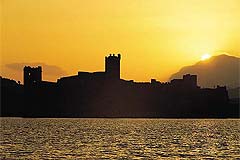 It is not in vain that Homeros called ‘the land of eternal blues’ Bodrum. Throughout history, formerly Halikarnassos, and then Bodrum, has been a place that cannot be shared and always struggled for.
It is not in vain that Homeros called ‘the land of eternal blues’ Bodrum. Throughout history, formerly Halikarnassos, and then Bodrum, has been a place that cannot be shared and always struggled for.
Bodrum is a region famous for its yachts and shipyards spread across the world its castle rising on the peninsula which consists of the merging of the eastern and western harbors, and its white houses lined up on the shores of the two harbors. Also it is famous for its cisterns and narrow streets leading down to the sea.
Today, Bodrum is an important tourism center that can gather all the elements expected from a holiday region and can be lived in summer and winter. It has potential to meet the expectations of all segments from rich yachts from all over the world to income groups who can spend a long summer holiday in a pension with a limited budget.  History: Bodrum is well-known for the cradle of many civilizations in the past. Bodrum, which has been invaded by countless invasions from the Aegean islands, has been an important center for those who want to dominate the Mediterranean. In the region between Ionian and Likia, there is Karya (Karia) which is smaller than the others. Halikarnassos became the one of the important cities of Karya. In Bodrum, Regional Historian Heredotus, Artemisia, the first woman admiral in history, and II. Artists such as Artemisia, Leachares, Shepas has grown.
History: Bodrum is well-known for the cradle of many civilizations in the past. Bodrum, which has been invaded by countless invasions from the Aegean islands, has been an important center for those who want to dominate the Mediterranean. In the region between Ionian and Likia, there is Karya (Karia) which is smaller than the others. Halikarnassos became the one of the important cities of Karya. In Bodrum, Regional Historian Heredotus, Artemisia, the first woman admiral in history, and II. Artists such as Artemisia, Leachares, Shepas has grown.
Bodrum has been under the rule of Persians, Macedonians, Roman Empire and Byzantine throughout history. Byzantine lost its Anatolian domination after being defeated by Alparslan the Sultan of Seljuk in Malazgirt in 1071. The Knights of Rhodes have been placed in Halikarnassos in 1415 by the Ottoman ruler Mehmet Çelebi. The Knights of Rhodes built sovereignty in the region by building the Bodrum Castle today. Kanuni Sultan Süleyman, who made the Mediterranean a Turkish lake, added Bodrum to the Ottoman lands along with Rhodes in the Rhodes Campaign he organized in 1522.
Climate: Winters are mild and rainy, summers are hot and dry. However, in the summer, the afternoon “breeze” affects the temperature.

